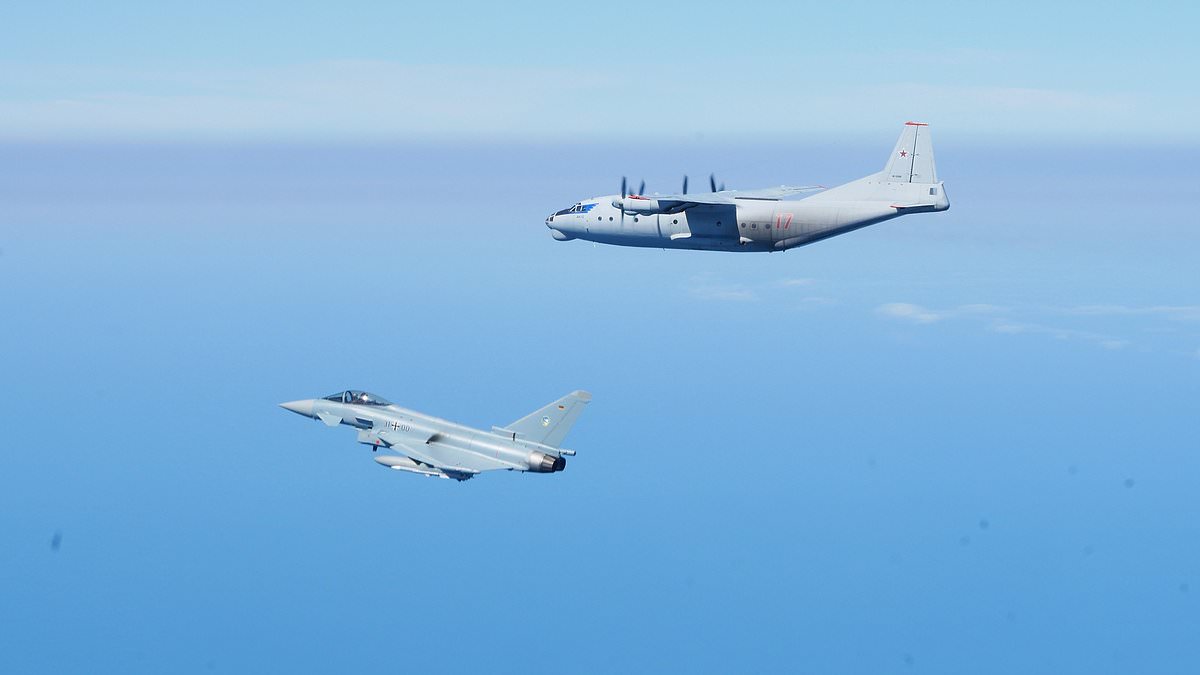NATO jets have scrambled to intercept Russian spyplanes as the alliance holds military drills in the Baltic Sea, officials have reported.
Several Russian aircraft have been intercepted in recent days by three separate NATO fighter squadrons of Germany, Italy and Spain, who launched from bases in Latvia, Poland and Lithuania respectively.
Unsettling images shared by NATO Air Command showed how Eurofighter Typhoon and F-18 jets flanked what appeared to be Ilyushin-IL20 spyplanes and Antonov AN-12 cargo aircraft soaring over the Baltic Sea.
‘We demonstrate our capabilities, readiness and our steadfast commitment to collective deterrence and defence,’ said General James Hecker, Commander Allied Air Command.
‘On a daily basis, Allied fighter jets are flying over the Baltic Sea,’ he added.
It comes as a NATO source last month said scrambles of the alliance’s jets to intercept Russian aircraft approaching allied airspace over the Baltic Sea region went up 20% to 25% in the first quarter of 2024.
A statement by NATO Air Command said that an increase in Russian activity in the skies over the Baltic Sea was expected in June, with NATO vessels taking part in planned drills.
Exercise Baltic Operations, or BALTOPS, runs from June 7 – 20 and will see more than 50 naval vessels, 25 aircraft and 9,000 personnel from 20 nations embark on maritime drills.
These exercises are an annual event, but this year’s are said to be the largest ever of their kind, owing to the increased security concern in the Baltic region following Russia’s invasion of Ukraine.
It comes as Sweden joins the exercises for the first time following its accession to the security bloc – a move which some analysts said turned the Baltic Sea into a ‘NATO lake’ in a blow for the Kremlin.
‘Year over year, BALTOPS delivers credible results in building our collective defense capability and the strength, agility and cohesion of the alliance,’ Vice Admiral Thomas Ishee, commander of the U.S. 6th Fleet and Naval Striking Support Forces NATO, told reporters in a pre-sail conference at Klaipeda in Lithuania.
BALTOPS 2024 will bring the largest assembly of amphibious and mine-hunting forces in the exercise’s history, according to a US Navy release, with Ishee telling reporters: ‘If anything that Russia’s brutal aggression in Ukraine has shown us is that you have to be able to adapt to the environment in combat, so that’s a focus for me and both my US command and NATO command.’
In Russia meanwhile, the large-scale exercises are seen as evidence of more threatening behaviour from NATO.
Ahead of the start of BALTOPS, Head of the FSB Border Service Vladimir Kulishov claimed NATO had increased intelligence activities in member nations bordering Russia and said the alliance was ‘working out scenarios for conducting military operations against Russia’.
And one of Russia’s leading Baltic experts, Nikolai Mezhevich, gave an alarming interview to Moscow’s Tsargrad outlet in which he claimed Western politicians were ‘ready to start World War III in the same place where the first and second began’ – referencing the possibility of a NATO attack on Russia’s Kaliningrad exclave.
‘It may well be that the exercises are some form of cover for a real military deployment, which will then go into the stage of an attack on Kaliningrad,’ he said.
Last year, NATO said allied fighter jets took off over 300 times to intercept Russian military aircraft, with most of the incidents occurring over the Baltic.
Since then, however, NATO has noticed a change in the mix of Russian aircraft spotted close to allied territory, the source, speaking on condition of anonymity, told Reuters.
Unlike in the past, Western pilots these days rarely detect any Russian fighter jets or strategic bombers approaching allied airspace, and most intercepts now involve surveillance aircraft or sometimes transport planes, the source said.
It is not clear why Russia has changed its behaviour but there is an assumption that Moscow needs its bombers and fighter jets in Ukraine as fighting there has been growing in intensity, the source added.
NATO says Russian military aircraft have a history of not transmitting a transponder code indicating their position and altitude, not filing a flight plan and not communicating with air traffic controllers.
Following Russia’s full-scale invasion of Ukraine in February 2022, the Western military alliance ramped up its presence along its eastern flank, sending more fighter jets there and setting up ground-based air defences.
NATO also deployed extra fighter jets to Romania after repeated Russian strikes on Ukrainian infrastructure close to the alliance’s southeastern border.
At the beginning of the year, NATO launched its largest exercise since the Cold War, involving some 90,000 troops.
The drills are meant to rehearse NATO’s execution of its regional plans – the first defence plans the alliance has drawn up in decades – detailing how it would respond to a Russian attack.
